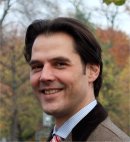|
Plenary Lecture
Computational Cardiology: Can we Predict the
Hemodynamics in the Human Heart?

Dr. Torsten Schenkel
Akademischer Rat
Institute of Fluid Mechanics
University of Karlsruhe
GERMANY
E-mail:
torsten.schenkel@kit.edu
Abstract:
Man's interest in the function of the body and it's
organs is very old. The heart has played a special role
in this as can be seen by the many non physiological
functions that have been and still are attributed to it.
From the beginnings of physiology with Da Vinci's
anatomical studies till today, the function of the heart
has been most intriguing. The number of mathematical and
physical models that have been developed to describe the
heart function are countless. The range is from very
simple models like the Laplace equation for ventricular
pressure and stress or the windkessel models that can
describe the circulatory system to complex multiscale
models that describe the electrophysiology, myocardial-
or hemodymics to name a few.
With the advent of modern computer technology it has
become feasible to tackle the more complex models that
cannot be solved in an analytical fashion and develop
virtual models for specific areas of interest within the
wide field of heart function.
I will give an overview over recent developments in
"Computational Cardiology" and present ideas and first
results for a multi-scale/multi-physics model of the
human heart.
Brief Biography of the Speaker:
Dr.-Ing. Torsten Schenkel obtained his diploma (Dipl.-Ing.)
in mechanical engineering at the University of Karlsruhe
in 1998, and the doctorate in the field of convection
flows and instrumentation of microgravity experiments in
2002 from the same university.
He is presently lecturer for fluid mechanics and
mathematical methods for flow simulations at the faculty
of mechanical engineering in Karlsruhe.
His research interest are in the field of
biofluidmechanics, especially heart flow, numerical
simulation of complex turbulent flows, aero acoustics
and turbulent heat transfer.
He currently is head of a research group for development
of a numerical model for patient specific simulation of
intraventricular flow, the Karlsruhe Heart Model KaHMo.
He has published over 20 research papers in conferences
and journals and has reviewed articles for a number of
scientific journals including Zeitschrift fur
Medizinische Physik, Microgravity Science and
Technology, Journal of Hydraulic Research, International
Journal for Numerical Methods in Fluids an Annals of
Biomedical Engineering.
|